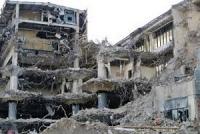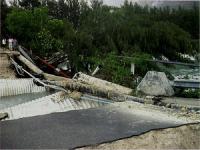-
Marine organisms as detectors of enemy undersea activity
Goliath grouper, black sea bass, and snapping shrimp, along with bioluminescent plankton and other microorganisms, are set to be the unlikely additions to protecting U.S. assets. Researchers are developing new types of sensor systems that detect and record the behaviors of these marine organisms and interpret them to identify, characterize, and report on the presence of manned and unmanned underwater vehicles operating in strategic waters. The incorporation of biological signals will extend the range, lifetime, and performance of undersea surveillance technologies in strategic waters.
-
-
Next-generation grid security tech
Researchers will demonstrate the effectiveness of metro-scale quantum key distribution (QKD) as a means of secure communication for the nation’s electricity suppliers. This initial milestone is part of the team’s three-year project focused on next-generation grid security.
-
-
And now, land may be sinking
In the coming decades, cities and towns up and down the eastern seaboard will have to come to terms with the impact of rising sea level due to climate change. A new study, however, is suggesting that rising sea levels may be only part of the picture — because the land along the coast is also sinking.
-
-
Rising seas disrupt local economies
Impacts from climate change are not always easy to see. But for many local businesses in coastal communities across the United States, the evidence is right outside their doors – or in their parking lots. High-tide flooding resulting from climate change is already disrupting the economy of Annapolis, Maryland. As sea levels rise, the impacts are expected to get worse for coastal communities.
-
-
Huawei espionage arrests in Poland: A wake-up call to Europe
U.S. and European intelligence services have been warning that Huawei, a jewel in the crown of the China’s growing technology industry, cannot be trusted in its protestations that it does not cooperate with the country’s intelligence agencies, or that it respects the rule of law and the intellectual property of its competitors. European governments should exclude Huawei from their telecommunications infrastructure before the company becomes too enmeshed in the continent’s 5G systems to be fully, securely, and painlessly removed at a later date. Failure to do so would give China truly unprecedented tools to corrupt, influence, and subvert Western democracies and the rule of law that is so vital to their continued health and the health of the post-War international system.
-
-
Keeping the lights on during and after a disaster

The threat of an inevitable earthquake is the uncomfortable truth we all face in the Cascadia Subduction Zone, which stretches from Alaska to California. Because the last major earthquake in the area was in the 1700s, our infrastructure developed without an appreciation and understanding of earthquake resilience. That means the next major earthquake will likely devastate our buildings, roads, bridges, and utility providers, posing immediate risks for the health and safety of those who live in the region. And later, there will be long-term economic aftershocks.
-
-
Using data utilization to augment community resilience, disaster response
A civil engineering who researches resilience against extreme events and natural hazards is responding to lessons learned from California’s deadly Camp Fire by outlining how to utilize the power of data to improve disaster response and minimize economic loss and human harm in similar events.
-
-
Paradigm shift needed for making bridges tsunami-resistant

Over the past fifteen years, big earthquakes whose epicenters were in the ocean off the coasts of Japan and Indonesia have caused tsunamis that killed more than 250,000 people and caused more than $200 billion in damage. The damage includes washing away or otherwise dislodging hundreds of bridges, emphasizing the need to better understand the wave impacts’ underlying physics. Researchers argue in a new study that a paradigm shift is needed for assessing bridges’ tsunami risk.
-
-
The opening moments of the Chernobyl disaster: New theory
A brand-new theory of the opening moments during the Chernobyl disaster, the most severe nuclear accident in history, based on additional analysis. The new theory suggests the first of the two explosions reported by eyewitnesses was a nuclear and not a steam explosion, as is currently widely thought.
-
-
Lawmakers tell Pentagon to redo climate change report
Earlier this month, the Pentagon, in compliance with a congressional mandate, released a landmark report which identified the 79 American military installations most vulnerable to the “effects of a changing climate.” Several Democrats on the House Armed Services Committee welcomed the report – but at the same time harshly criticized it for failing to include details requested by Congress, among them the estimates by each of the armed services of the cost of protecting or replacing the ten most vulnerable military bases.
-
-
Rising seas: to keep humans safe, let nature shape the coast
Even under the most conservative climate change scenarios, sea levels 30cm higher than at present seem all but certain on much of the U.K.’s coast by the end of this century. Depending on emission scenarios, sea levels one meter higher than at present by 2100 are also plausible. The knee-jerk reaction to sea level rise has traditionally been to maintain the shoreline’s position at all cost, by building new flood defense structures or upgrading old ones, but this traditional approach of “grey” engineered sea defenses locks society into ever increasing costs of replacement and maintenance. The alternatives are “nature-based solutions” to coastal flooding and erosion, which work with natural processes to reduce flood risk and incorporate ecosystems into flood defense.
-
-
Comparing technologies to remove arsenic from groundwater
At least 140 million people in 50 countries have been drinking water containing arsenic at levels above WHO guideline. A new study compares for the first time the effectiveness and costs of many different technologies designed to remove arsenic from groundwater.
-
-
Under-road heating system to keep Europe’s highways ice-free
Snow and ice can dramatically change the conditions of a road, where slippery surfaces make it harder to keep control of a vehicle, particularly when braking or turning. Under-road heating that melts ice and snow within 15 minutes and real-time information about icy road conditions could help prevent wintertime accidents.
-
-
Transformative grid technology
Avista and the Department of Energy’s Pacific Northwest National Laboratory announced they will enter an agreement to strengthen and expand their partnership at the frontiers of grid modernization. The scope of the new agreement includes collaboration on new battery and thermal storage technologies, and the development and testing of transactive building controls for increased grid reliability and resiliency.
-
-
Understudied terrorists put under a microscope
Bombs exploding, hostages taken and masked gunmen firing machine guns are all types of terrorist attacks we’ve seen. According to a new study, it’s the attacks we don’t see – cyberattacks – that happen more often and can cause greater destruction. “Little work has been done around the use of the internet as an attack space,” said Thomas Holt, Michigan State University professor of criminal justice and lead author. “The bottom line is that these attacks are happening and they’re overlooked. If we don’t get a handle understanding them now, we won’t fully understand the scope of the threats today and how to prevent larger mobilization efforts in the future.”
-
More headlines
The long view
Helping Strengthen America’s Critical Infrastructure
Everyday life depends on a robust infrastructure network that provides access to running water, communications technology and electricity, among other basic necessities. The experts who keep our national infrastructure secure and resilient also need a strong network to share their knowledge and train the next generation of professionals capable of solving complex infrastructure challenges.
AI and the Future of the U.S. Electric Grid
Despite its age, the U.S. electric grid remains one of the great workhorses of modern life. Whether it can maintain that performance over the next few years may determine how well the U.S. competes in an AI-driven world.
Using Liquid Air for Grid-Scale Energy Storage
New research finds liquid air energy storage could be the lowest-cost option for ensuring a continuous power supply on a future grid dominated by carbon-free but intermittent sources of electricity.
Enhanced Geothermal Systems: A Promising Source of Round-the-Clock Energy
With its capacity to provide 24/7 power, many are warming up to the prospect of geothermal energy. Scientists are currently working to advance human-made reservoirs in Earth’s deep subsurface to stimulate the activity that exists within natural geothermal systems.
Experts Discuss Geothermal Potential
Geothermal energy harnesses the heat from within Earth—the term comes from the Greek words geo (earth) and therme (heat). It is an energy source that has the potential to power all our energy needs for billions of years.
